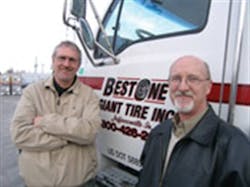Bob Youell and Kent Hofacker didn’t want to do it, but they had no choice. Several years ago, Youell and Hofacker, president and vice president, respectively, of Best One Giant Tire Inc. in re-related businesses, had been working with OTR tires for more than 35 years. Hofacker had spent 25 years at Shraders Inc., now Craft Tire Inc., a major OTR tire dealership. Best One Giant Tire’s ownership also includes several silent partners.) The list included people from all over the world.
They hit the phones, starting with individuals they personally knew. They began to contact third-party referrals. “And sometimes those referrals would give us referrals,” says Youell. “We tried to come up with our A-list — people who could fill the gaps between what Titan/General and Bridgestone were supplying.”
He and Hofacker didn’t have any set criteria; everyone was a potential supplier. “We would test the waters,” says Youell. “We would buy a couple of tires and see if they would be shipped here in a timely fashion, how their billing came and if the tires had legitimate serial numbers on their sidewalls. Instead of giving somebody an order for 10 tires, we might order two and pay the freight. If the transaction went without a hitch, we’d order the other eight.
“We found out pretty quickly that there were people who were going to exploit the shortage and try to sell a tire for 10 times what it was worth. We found that to be distasteful. There’s a fair market value for any product and we felt (what some suppliers were asking) was way beyond what was reasonable or ethical.”
False information wasn’t uncommon. “In some cases, we would get information saying that some tires were available,” says Hofacker, “but then we’d call and find that the tires weren’t available or that pricing had changed.”
Best One Giant Tire also found itself dealing with brokers of other products who had connections — in some instances, shaky — to OTR tire suppliers. “Sometimes people who had no involvement in the tire industry found tires for us,” says Youell.
One such individual was an importer based in Poland who had tire contacts in Russia. After several conversations with the broker, Youell and Hofacker decided to buy some tires (under the Belshina and Ukraine Research brand names) from one of his Russian contacts. “We had no history with this vendor but we felt it was a good enough risk,” says Youell.
To swing the deal, Best One Giant Tire had to wire several hundred thousand dollars to a bank in Poland, anticipating the tires would be shipped within 30 days. Thirty days passed; no tires. Forty days passed; again no tires.
[PAGEBREAK]
“I got way out of my comfort zone,” says Hofacker. Meanwhile, Higgins was making daily phone calls to the broker in an attempt to track their movement.
The tires showed up after 45 days. When the tires arrived, Youell and Hofacker noticed their check had been cashed significantly earlier.
The tires turned out to be good. “They weren’t super tires, but they were functional,” says Youell. “The inner liners, the sidewalls, the tread — everything looked like a workable tire.”
He and Hofacker remember breathing a sigh of relief at the discovery. Both admit they would not have had much recourse if the tires were junk. That’s why they made sure customers knew the risks up front. “Before we ordered the tires, we went to our customer and said, ‘We can get these tires,’’ says Hofacker. “’They’re big, black and round and are the right size, but we don’t think we’re going to get any kind of consideration if something (is wrong) with them. We have to sell them as-is.’”
“It came down to having a relationship with your customers versus not having a relationship with your customers,” explains Youell. “We’re partners with our customers. And because of that relationship, they were willing to take the risk.”
Best One Giant Tire also established a level of trust with its Russian source, who didn’t ask them to wire money in advance during a subsequent transaction.
Established contacts
At the same time Best One Giant Tire was sourcing OTR tires from Russia, it was cultivating contacts in China.
During the second half of 2005 and all of 2006, Best One Giant Tire “had a container on the water every 45 days.”
The dealership reduced its imports by roughly 35% in 2007 as its main-line suppliers began to ramp up production.
It will continue to give Titan and BFNT first crack at orders, but tires from less mainstream sources will remain a significant part of its mix. “We’ll continue to have some kind of relationship with these suppliers ,” says Youell.
“We don’t want to get in a predicament again where we have to recreate all of this networking. We started at ground zero -- not having connections with anybody outside of the majors. We had to develop our own road map.”
Best One’s best practices: Proper pressure is critical to OTR tires
You can’t always control what happens to an OTR tire when it’s in the field, says Kent Hofacker, co-owner of Best One Giant Tire Inc. in Jeffersonville, Ind. But you can control its air pressure. “We’ve been educating all of our customers about air pressure.”
Hofacker tells end users like mines and construction firms the best time to check air pressure is on Monday mornings after tires have been out of service for a while and have cooled down. “Get them to the proper psi level and you’ll reduce your cost by 20%.” Proper psi levels also ensure good casings for retreading, he says. (Best One Giant Tire outsources its OTR tire retreading.)



